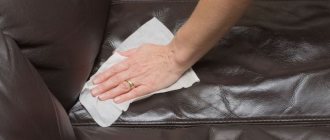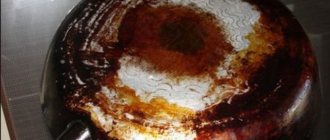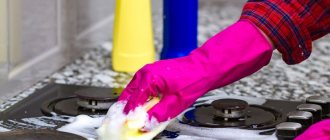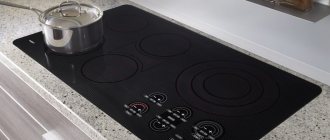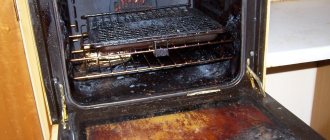Recommendations for caring for an induction cooker
Before you learn how to clean an induction hob, there are a few tips you should pay attention to:
- You can start cleaning the stove only when the surface has completely cooled down, otherwise traces of the soap solution may remain on the glass ceramics.
- Before you start cooking, you must completely clean the glass panel from carbon deposits and greasy marks, otherwise the dirt will stick to the surface even more, and it will be more difficult to get rid of them in the future.
- If sugar, jam, a piece of polyethylene, etc. gets on the stove during cooking, you must immediately turn off the appliance and remove the contamination with a soft cloth. This is done to avoid damage to the surface when trying to clean off the caked mass.
- Only soft cloths and sponges are suitable for care. Metal scrapers and hard surface sponges can leave scratches on the slab.
Metal sponge is the enemy of glass ceramics
General tips for cleaning your stove
Maintaining the bright and shiny glass surface of an induction hob is not easy at first glance. But by choosing the right cleaning product and using proven methods and recommendations, you can greatly simplify this task:
- To wash the stove, you should have a separate soft sponge or rag. It is not recommended to use a sponge for washing dishes, as the grease that accumulates on it can leave streaks.
- Dried dirt is very difficult to remove from the surface of an induction cooker, so it is better to remove drops of fat and food particles immediately after cooking.
- To clean glass ceramics, it is recommended to use a special cleaner for induction cookers, which creates a thin protective layer on its surface.
- Dishwashing detergents or oven cleaners are not suitable for this material, as they will leave noticeable streaks. As an analogue, you can use an alcohol-containing window cleaning spray.
- After cleaning, the surface of the stove must be wiped with a clean damp cloth and wiped dry.
- Sugar is the main enemy of an induction cooker. If drops of syrup or jam get on its surface, they should be immediately removed with a cloth soaked in warm water, and then wiped with a special product.
Daily Cleaning
It is recommended to clean the induction hob daily to prevent dirt from sticking to the surface. To care for the glass-ceramic surface you will need the following tools:
- Soft sponge and soft cloth;
- Cotton napkins or paper towels;
- Special silicone scraper for induction cookers.
For glass ceramics, use only soft sponges.
As a detergent, you can use dishwashing detergent or a special composition for caring for glass ceramic hobs.
To clean the stove, you need to do the following:
- Wait until the surface cools down, soak a sponge in a soapy solution and wipe the glass-ceramic surface.
- Thoroughly rinse the soap off the stove and wipe it dry with a soft cloth.
- The final touch is polishing with paper towels or a cotton cloth.
A microfiber cloth is suitable for cleaning your induction hob.
For perfect shine, polish the glass panel with a cotton cloth.
If you do not neglect this daily procedure, the stove will always shine clean.
How to clean and how to wash an induction cooker and hob
The induction hob is a real decoration of the kitchen set. It looks sophisticated and elegant, so it perfectly complements the design of a modern kitchen.
Caring for an induction cooker must be special. Before you start cleaning the glass-ceramic surface, we recommend that you study information about safe and effective methods for removing dirt that will not spoil the appearance of the glass-ceramic or induction hob. We looked in more detail about which stove is better, electric or ceramic, in this article.
General cleaning
Not everyone is able to care for the stove every day; as a result, the surface requires cleaning using more serious methods. To get rid of burnt food particles, you must first soak them. To do this, soak soft cloths in the detergent solution and place them on all problem areas. After a few minutes, the dirt will soften, and you can easily clean it off with a scraper (hold the scraper at an angle of 45 degrees to the surface). Finally, follow steps two and three from the previous section.
The scraper for induction cookers is equipped with a replaceable nozzle
If after such manipulations there are white spots on the glass panel, remove them with table vinegar. Soak a soft cloth in it, wring it out and walk over the whitened areas.
In a situation where caked-on deposits just don’t want to be cleaned off, sometimes you just want to use an aggressive cleaning agent for plumbing fixtures or tiles. Under no circumstances should this be done! Exposure to caustic chemicals can cause permanent damage to the slab surface. To remove “stubborn” dirt, re-place the cloth with the cleaning solution on it, but hold it a little longer, and then repeat the scrubbing.
The use of abrasive products can lead to this result
Caring for glass ceramic and induction hobs
If you have an induction or glass-ceramic hob in your kitchen, then to clean it from dirt you should apply a liquid intended for cleaning kitchen surfaces and, shortly after that, wipe it well with an absorbent cloth. Be careful not to damage the surface of the glass, which means putting aside any abrasive objects (for example, steel wool to remove dirt, which is always very tempting to use).
To get rid of stubborn stains after eating, you can use products specifically designed for this operation so as not to damage the surface. grease remover sprays and gels for stoves and ovens in the store.
, the result of their work is significantly superior to home remedies. Schumanit will help you quickly forget about stubborn and stubborn stains. Spray it liberally onto the dirty area, wait a little and wipe the hob with a sponge or cloth. The downside of such products is that they have an unpleasant odor, so if you are simultaneously treating both the hob and oven trays, then a cotton-gauze bandage may be a good idea. And make sure that the spray does not come into contact with food or clean dishes. Wear rubber gloves!
Use only delicate cloths (microfiber is best) to dry the stove. Glass-ceramic plates are very easy to scratch, so you shouldn’t even move dishes on its surface. Make sure that the diameter of the pots and pans matches the diameter of the burner you are using. And so that the cooking utensils are, in principle, suitable for induction or glass-ceramic stoves.
How to clean an induction cooker using traditional methods
If you don’t have a special cleaning composition at hand, then folk methods will help you deal with soot. One of the simplest remedies is baking soda, which works great even on stubborn stains. You can use it like this:
- Mix baking soda powder with water to form a paste.
- Apply to contaminated areas and wait about 5 minutes.
- Carefully begin removing the paste using a damp soft cloth.
- If you see that not everything has been cleaned, then pour a little vinegar onto the soda mixture - this will help remove stubborn deposits.
- Wipe the stove several times with a clean cloth, periodically rinsing it with water and squeezing it out.
Baking soda is an environmentally friendly detergent
Ammonia
It works effectively in cases where it is necessary to remove stains from escaped milk from a glass panel. 1 part alcohol should be diluted in 5 parts water, pour the resulting mixture into a spray bottle and spray it onto the surface of the glass. After 10 minutes, wiping the stove with a soft cloth, you will see a clean, shiny surface.
To distribute the cleaning solution evenly, pour it into a spray bottle
Oil
Any vegetable oil is an excellent means for cleaning glass ceramics. Apply it to a soft cloth and apply it to the dirt, and after half an hour, wash the surface with detergent. Wipe the stove with a clean, damp sponge.
Vegetable oil will help save detergent
Oil can be used not only for cleaning, but also to prevent future contamination. After cleaning the stove, wipe it with a cloth lightly moistened with oil. A protective film is formed on the surface, which allows you to remove any stains with a damp cloth without detergent.
Clean glass ceramics from carbon deposits
During cooking, various fat formations remain on the surface of the glass-ceramic stove. The following recommendations will help you get rid of old fat and carbon deposits at home:
- Regular warm water will help remove minor formations on the panel. Spray it in the dirty area and then remove the deposits with a sponge;
- In the case of a medium degree of fat deposits, apply a special cream or a gentle household solution to the surface. After some time, it is wiped off with a rag;
- Old carbon deposits from a glass stove are removed using a product containing alkali. It is applied to the contaminated area and after 30 minutes it is removed with a soft material;
In addition, available household products help remove carbon deposits from glass ceramics.
For example, vinegar is an ideal and safe option for cleaning a glass ceramic hob.
Vinegar has a disinfecting effect and removes any bacteria and microorganisms from the surface.
Preparing a vinegar-based cleanser involves the following steps:
- The first step is to mix equal parts vinegar and water;
- The second step is to pour the solution into a spray bottle;
- The third step is to spray in the area of contamination and wait a few minutes;
- Then wipe the stove with a dry cloth.
After these activities, the stove will shine like new.
Information. Regular baking soda also helps housewives fight carbon deposits on the stove.
The product is mixed with water to a paste-like state and distributed over the contaminated area. The paste is left for a few minutes and then removed with a sponge and wiped with a dry cloth. If necessary, the procedure is repeated several times. This is interesting: How to remove super moment glue from the skin of your hands
Glass from burnt milk
Not only grease stains can remain on the surface of a glass stove. Often the stove has to be cleaned of burnt milk. Regular oil will help remove organic contamination from the surface.
Wait until the contaminated area has cooled down before starting work.
Otherwise, you may get burned and damage the material.
It is recommended to use olive oil to clean glass ceramics.
The product must be applied to a rag or piece of cotton wool and left on the contaminated area for 20-30 minutes.
After this, you can remove the milk stain with a sponge. The oil acts as a softener and helps quickly remove organic stains. After this, the slab is polished with window cleaner.
Important! It is worth noting that vegetable oil acts as a protective agent. Apply a thin layer of oil to the surface and rub. As a result, the slab is covered with a protective film, which allows you to quickly remove any stains.
The ideal product for cleaning glass-ceramic hobs is ammonia. The solution can remove any stubborn stains and deposits, and also polish the slab well. To prepare the solution, mix ammonia with 250 ml of water. After this, distribute the product in the area of contamination for 10 minutes. Then wipe the area thoroughly with a dry cloth.
In the area of the burners, it is recommended to remove stains from burnt milk using a soft sponge with the addition of a soap solution. In addition, a ceramic cleaner, but without abrasive particles in the composition, will help cope with organic contamination.
Additional recommendations for induction cooker owners
In order for the electric stove to please you with its ideal appearance for a long time, you should adhere to the following recommendations:
- Use only cookware for this type of stove that has a perfectly flat bottom.
- Do not move pots and pans across the stove: this may cause micro-scratches on the glass that cannot be removed with detergent.
- Make sure the bottom of the pan is completely dry before placing it on the surface.
- If vegetables are peeled near the hob, particles of soil that fall on the glass can cause micro-scratches. Therefore, it is better to wash potatoes and peel carrots away from the stove.
- To clean the appliance, it is advisable not to use powder detergents: sometimes the powder does not dissolve completely, and solid particles can damage the hob.
Look for special markings on the cookware
Cleaning a stove that operates on the induction principle is not particularly difficult if you take into account some nuances. To ensure that your equipment lasts a long time and pleases you with its impeccable appearance, use only soft cloths and a special silicone scraper to care for it.
Recommendations for choosing detergents
It is better to use products that are specifically designed for this purpose to clean the hob. They contain a substance that creates a film that performs a protective function. As a result, the stove does not become so dirty, and food that gets on it does not burn. Popular products that do their job well:
Important: under no circumstances should you use metal sponges, abrasives, or objects that can damage the stove by scratching it to clean the glass-ceramic stove.
Vinegar and baking soda for stubborn stains
The proven combination of vinegar and baking soda is also ideal for cleaning your induction cooker. The first should be carefully sprayed onto a cold plate, and then thoroughly clean the entire surface with a damp cloth; Sprinkle it with baking soda and cover it with a damp cloth. When exposed to baking soda and vinegar, dirt and sediment will quickly dissolve and can therefore be easily removed with a cloth. Repeat the procedure for best results. After polishing the plate with a cloth soaked in vinegar, the plate will look like new. Useful tips for home
- How to get rid of bedbugs?
- How to fertilize orchids?
- Glycerin softens towels and instantly removes stains and dirt


